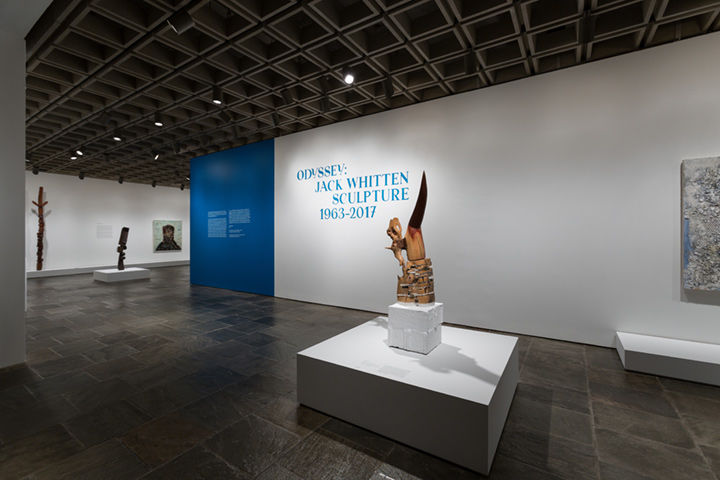
This exhibition presents the extraordinary sculptures of American artist Jack Whitten (1939–2018). Although he has long been recognized for his accomplishments as an abstract painter, his sculptures have been largely unstudied until now.
Born in Bessemer, Alabama, Whitten moved to New York in 1960 and promptly joined a dynamic and diverse community of artists, poets, and jazz musicians living both downtown and uptown. Around 1962 he created his first sculptures. Whitten redoubled his commitment to the medium in 1969 when he began spending summers on the Greek island of Crete. His sculptures consist of carved wood and locally sourced, usually repurposed materials, such as bone, marble, paper, glass, metal, and fishing line. In addition to serving both aesthetic and ritualistic ends, they are inspired by traditions rooted in Africa, the Southern United States, and ancient and present-day Mediterranean. As such, they express a cosmopolitan perspective, one that transcends historical eras and national boundaries—reflecting the geography of Whitten's life as well as that of members of the diaspora as a whole.
Forty of Whitten's sculptures are joined in this exhibition by eighteen of his paintings, including the entire Black Monolith series (1988–2017). Together they demonstrate technical, conceptual, and thematic parallels between his practice in two and three dimensions. Odyssey also features sixteen African, Cycladic, Minoan, Mycenaean, and American objects from The Met, whose collections were a lifelong resource for the artist. Integrated throughout the exhibition, these works signal Whitten's myriad art-historical debts, acting as potent reminders of the rich histories out of which contemporary art arises.
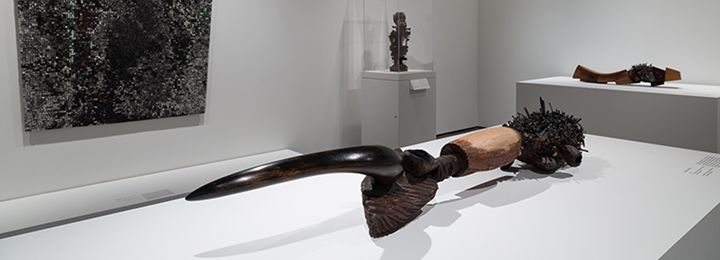
In 1960 Whitten fled the South, where Jim Crow laws and racial violence left him and other African Americans afraid for their lives. He moved to New York and enrolled at the Cooper Union to pursue an art degree.
His study of African art intensified during this time. In addition to frequenting the collections of African art at The Met and the Brooklyn Museum, Whitten also explored the holdings of gallerist Allan Stone, whom he met in 1964. Aesthetic, spiritual, and political circumstances further catalyzed his interest in African art. According to Whitten, wood-carvers from the continent discovered the grid, "the universal structure" or "DNA" of perception and representation, a breakthrough he adapted for his own purposes.
The 1960s also marked the heyday of the civil rights, Black Power, and Pan-African movements, and many artists and writers of the diaspora, Whitten included, embraced African traditions in an effort to reclaim a common ancestral legacy and engage with their creative inheritance. Whitten's sculptures from the 1960s and 1970s, in particular, reflect his innovative response to the forms, materials, and techniques of African art. The sculptures in this gallery testify to the lasting impact of Kongo power figures, or minkisi, especially.
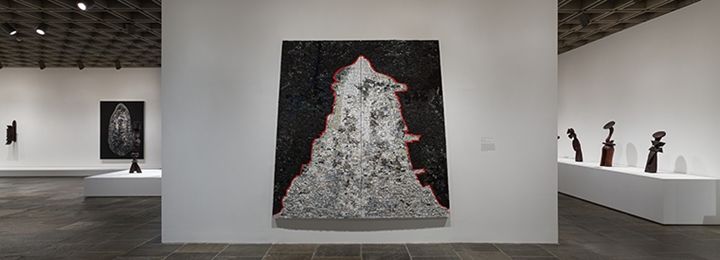
In 1988 Whitten created the first of what would become eleven Black Monolith paintings devoted to exemplars of black excellence in art, music, literature, sports, and politics. Whitten described these works in terms of zographos, from the Greek words for zo (life) and graphos (to write).
"There are so many Black Monoliths in the history of African Americans," he once said. "Our history of survival in America is defined both by the heroic deeds of the collective, and of the independent activists working in a variety of disciplines."
The paintings in the series, titled after a rocky outcropping near his home on Crete, are inspired by the mosaics Whitten studied in Egypt, Italy, and other parts of the Mediterranean. Unlike traditional paintings, in which paint is applied with a brush, the Black Monoliths are built in a way that parallels his sculptures. All but one of these paintings are composed of tesserae, small units of color, that Whitten made by pouring pigment and acrylic into molds, usually recycled bottle caps and plastic packaging. Before adhering the pieces to the canvas, he sometimes cut, broke, and ground them.
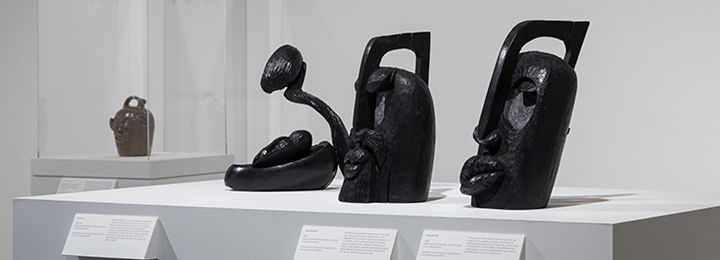
Whitten moved to New York in 1960 and began carving wood in 1962 while studying painting at the Cooper Union. There, he sought technical advice from professor and artist Leo Amino (1911–1989); sculptor Christopher Wilmarth (1943–1987), a fellow student, lent him tools.
For Whitten, wood carving was a means to an end, and that end was not, at least at first, the creation of sculptures. Instead, he sought to better understand the practice of hand-carved wood sculpture from Africa, which he first encountered during visits to New York museums in 1958 and 1959. Reading about and viewing these objects only helped so much; Whitten quickly realized he needed to make in order to truly learn. His earliest sculptures, on view in this gallery, reflect the techniques, aesthetics, and functions of African sculpture.
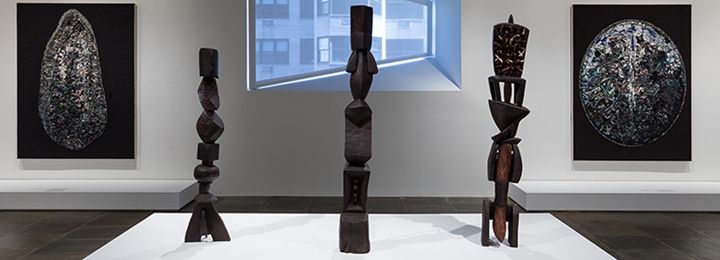
Whitten's sculptures fall into a few loose categories, each defined by its form, shape, and purpose, but with considerable overlap between them. The earliest works in the exhibition are carved-wood face jugs, which resemble the ceramic face vessels created by enslaved potters in the Edgefield District of South Carolina during the mid-nineteenth century.
The second type consists of totems or totem-like sculptures that represent Whitten's ancestors and members of his immediate family. These are closely related to a set of reliquaries and guardian figures devoted to blood relatives as well as legendary musicians and activists like John Lennon and Malcolm X. While the guardians protect, the reliquaries commemorate, often by collecting materials and memories associated with the person or animal in question.
In the final category are the blades, which exemplify Whitten's interest in the pointed-crest motif, a universal symbol of power. All these sculptures are meant to embody and channel the living forces they represent, serving as containers of both matter and spirit.
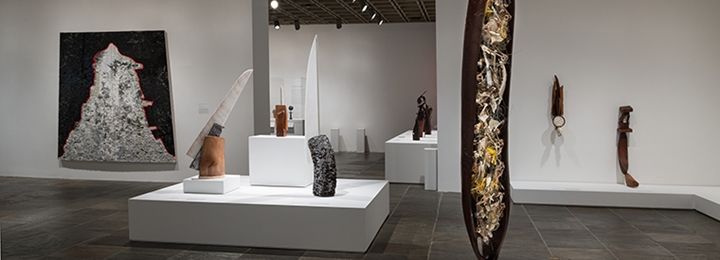
As the 1970s gave way to the 1980s, Whitten built a house in Agia Galini, the Cretan village he first began to visit in 1969. His sculptures from this period reflect an even more heartfelt and substantive engagement with the past and present of the Mediterranean region—from its ecology and biology to its art, history, and people.
In order to feed his love of art history, he often visited museums in Athens and Heraklion, Greece, where he studied Mycenaean marine vessels, marble Cycladic figures, and Minoan snake goddesses, among other objects. Whitten also scrutinized the frescoes at the Minoan palace of Knossos (1450–1400 B.C.), one of which features a depiction of two black soldiers marching in stride with a Minoan man.
Whitten was fascinated by these signs of transcontinental exchange, and throughout his career he stressed the proximity—whether social, cultural, or geographic—of Europe and Africa.
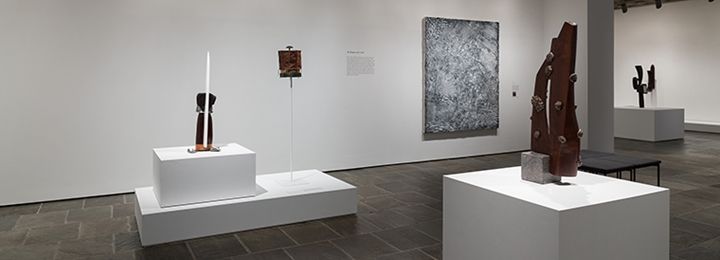
While most of Whitten's paintings were made in New York, the vast majority of his sculptures were produced in the Cretan village of Agia Galini, in an outdoor workshop. Unlike his paintings, the sculptures were never intended for mass consumption, especially in the competitive, rarefied New York art world. Indeed, none of his sculptures were offered for sale during his lifetime, and prior to this exhibition, Whitten displayed them only twice, in 1984 and 2011, in Agia Galini.
As their predominantly modest size suggests, these works were private in nature, their creation an act of ritual as much as expression. Of great personal significance to the artist, many were on view in his home.
Jack Whitten (American, 1939–2018). The Tomb of Socrates (detail), 2009. Wild cypress, black mulberry, marble, brass, mixed media, 26 x 20 1/2 x 8 1/4 in. (66 x 52 x 21 cm). Collection of the Artist's Estate. © The Estate of Jack Whitten. Courtesy The Estate of Jack Whitten and Hauser & Wirth